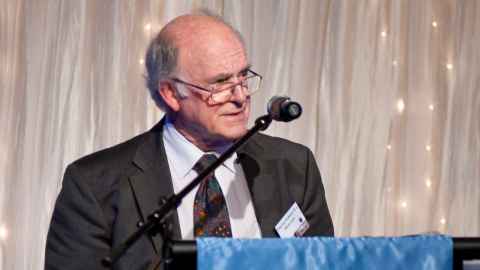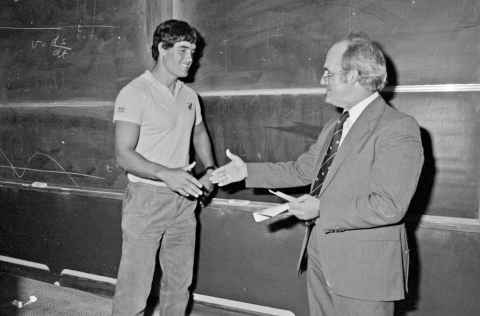Tribute to Professor Raymond Meyer
1 August 2018
Delivered by former Vice-Chancellor Sir Colin Maiden at Ray's funeral, this eulogy pays tribute to Professor Raymond Meyer, highlighting his many personal qualities and enormous contribution to the University.

BE NZ, PhD Manc., FCASI, MAIAA, FIPENZ, FRAeS
5 October 1931 – 5 July 2018
Today we honour and celebrate the life of Ray Meyer. And there is much to celebrate. Ray was a fine man in all respects. A good family man and friend, with wonderful personal qualities. He was kind and generous, always trying to help others, fun to work with, had a good sense of humour – that little chuckle – and had excellent leadership and organisational skills. Ray was also a very practical man due to his secondary school education at Wellington Technical College. He built a large part of his bach in the Bay of Islands, even installing the plumbing.
Ray did well academically at Wellington Tech and Victoria University College and subsequently enrolled for a Bachelor of Engineering degree in Mechanical Engineering at Canterbury University College in 1951. Again he excelled and after graduation, was accepted into the Defense Scientific Corps.
Ray and Dorothy - a great team
Ray became a flying officer in the RNZAF, dress uniform and all, and then by mutual agreement enrolled at the University of Manchester to undertake a PhD in High Speed Aerodynamics. On the way to the UK by boat, he met Dorothy who was travelling to the US to take up a Fulbright grant. They corresponded and later married in Manchester. Through the years, Ray and Dorothy have been a great team, supporting each other’s activities. Even in later years, Ray accompanied Dorothy all over the world to meetings of the International Federation of University Women where she was an active participant and he a strong supporter of its ideals.
After completing his PhD Ray was to return to New Zealand to earn out his short term commission, but no suitable defence position was available. Instead he was posted to work for the National Research Council of Canada in its National Aeronautical Establishment in Ottawa.
Canada
Here, Ray continued his research on high speed aeronautics, particularly in hypersonics. I first met Ray when he visited the Defense Research establishment outside Quebec City, where I was working. Several years later we met again at the annual meeting of the American Institute of Aeronautics and Astronautics at the Waldorf Astoria Hotel in New York. There were two other Kiwi engineers attending, Bill Rainbird and Bob Bilger, and that night we had drinks and dinner together and went to see the Rockettes at Radio City Music Hall.
Dean of the Faculty for 18 years, he oversaw the expansion of the School
to include women students, increased staffing and activity, lifted
standards and reputation and helped many students.
University life
After some 11 years at the National Research Council, where Ray had become deputy director of the National Aeronautical Establishment, he applied for the Chair of Mechanical Engineering at the University of Auckland. Offered the post, he agonised before deciding to return to New Zealand. When I became Vice-Chancellor of the University in 1971, Ray was well established in the Engineering School, and what a remarkable contribution he made to both the School and the University.
Head of Department for five years, Dean of the Faculty for 18 years, he oversaw the expansion of the School to include women students, increased staffing and activity, lifted standards and reputation and helped many students.

Helping Russell
One such student was Russell Coutts, who, because of his extensive yachting activities, was struggling academically. Ray met with Russell and his father and, having an interest in yachting, encouraged Russell to complete his degree. Russell’s academic performance improved and he did complete his Bachelor of Engineering.
Ray and I both thought that Russell having an engineering degree gave New Zealand a competitive advantage in America’s Cup racing. Russell could contribute to the design of these sophisticated yachts and understood how to sail them. It is of interest that Peter Burling, our present America’s Cup skipper, also has an engineering degree.
Ray made many contributions to the University outside the Engineering School. He was chairman of the computer committee for many years, from the days of the large Burroughs Main Frames, and punch cards, to the introduction of personal computers and the internet.
Tamaki days
After stepping down as Dean, he became Assistant Vice-Chancellor Tamaki, responsible for the development of the Tamaki Campus from the remnants of the 1990 Commonwealth Games Village.This allowed the University to expand student numbers and house new research activities such as Oncology, Composite Materials and Sail Design. With the sale of Tamaki, the engineering research activities were moved to the impressive new Khyber Pass campus. There it is most appropriate that the main entrance building be named in Ray’s honour.
Auckland UniServices Ltd
Another major contribution of Ray’s was to the development of Auckland UniServices Limited from the early 1970s, when it started as the Applied Research Office. Ray was Deputy Chairman for 18 years. Today UniServices does well over $100 hundred million dollars of business annually with Government and the private sector, and has spawned companies worth hundreds of millions of dollars. It is the best of such University companies in Australasia, and Ray Meyer can be given credit for much of this success. Ray had many other activities outside the University, both before and after he retired in 1996. He was president of IPENZ for a term and there is an IPENZ Award, the Ray Meyer Medal, awarded annually for the most innovative student project at New Zealand Engineering Schools.
Chairman of the board
Ray was particularly active in energy matters, from the time of the first oil shock in 1973. He was a member, and later chairman, of the New Zealand Energy, Research and Development Committee, Chairman of the Energy Advisory Committee, a Director of the Electricity Corporation of New Zealand and Chairman of Transpower.
Among his other activities, Ray was the founding chairman of TELARC, the body that tests and registers technicians in New Zealand. He was also chairman of the board of directors of the Forest Research Institute and Deputy Chair of Watercare Services. He represented New Zealand as a member of the University Grants Committee and the University Council of the University of the South Pacific. Also Ray was New Zealand representative in setting up The Washington Accord, an international accreditation agreement for professional engineering degrees, in 1989.
Altogether a remarkable record of achievement both within and outside academia. Ray Meyer made a major contribution to the well being of this country. Thank you Ray, rest well old friend.
Sir Colin Maiden
BE, ME DPhil Oxf. HonLLD
Former Vice-Chancellor, University of Auckland